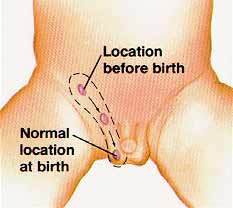Undescended testicle
Also called as Cryptorchidism;
Empty scrotum - undescended testes; Scrotum - empty (undescended testes);
Monorchism; Vanished testes - undescended; Retractile testes
Causes
Most of the time, a boy’s testicles
descend by the time he is 9 months old. Undescended testicles are fairly common
in infants who are born early. The problem occurs less often in full-term
infants.
Some babies have a condition called
retractile testes and the health care provider may not be able find the
testicles. In this case, the testicle is normal but is pulled back out of the
scrotum by a muscle reflex. This is able to occur because the testicles are
still small before puberty. The testicles will descend normally at puberty and
surgery is not needed.
Testicles that do not naturally
descend into the scrotum are considered abnormal. An undescended testicle is
more likely to develop cancer, even if it is brought into the scrotum with
surgery. Cancer is also more likely in the other testicle.
 Bringing the testicle into the
scrotum can improve sperm production and increase the chances of good
fertility. It also allows the health care provider to do an exam for the early
detection of cancer.
Bringing the testicle into the
scrotum can improve sperm production and increase the chances of good
fertility. It also allows the health care provider to do an exam for the early
detection of cancer.
In other cases, no testicle may be
found, even during surgery. This may be due to a problem that occurred while
the baby was still developing before birth.
Symptoms
Most of the time there are no
symptoms other than the absence of the testicle in the scrotum. (This is called
an empty scrotum.)
Exams and Tests
An exam by the health care provider
confirms that one or both of the testicles are not in the scrotum.
The health care provider may or may
not be able to feel the undescended testicle in the abdominal wall above the
scrotum.
Imaging tests, such as an ultrasound or CT scan, may be done.
Possible Complications
Treatment
In most cases, the testicle will
descend without treatment during the child’s first year. If this does not
occur, treatment may include:
·
Hormone injections (B-HCG or testosterone) to try to bring the testicle into
the scrotum


